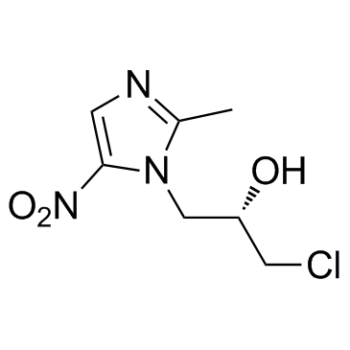Levo-Ornidazole [also known as (S)-Ornidazole; Levornidazole] is the levo-isomer of ornidazole which is a 5-nitroimidazole derivative with antiprotozoal and antibacterial properties against anaerobic bacteria. Levo-Ornidazole is the less active isomer. Ornidazole is a approved drug that cures some protozoan infections. It has been investigated for use in Crohn's disease after bowel resection. Synthesis is a straightforward reaction between 2-methyl-nitroimidazole and epichlorohydrin under acid catalyst conditions. After passive absorption into bacterium cell, the nitro group of ornidazole is reduced to amine group by ferrodoxin type redox system. The formation of redox intermediate intracellular metabolites is believed to be the key component of microorganism killing for Ornidazole. The drug is active against anaerobic bacteria viz. Peptostreptococcus, Clostridium, B. fragilis, Prevotella, Porphyronomas, Fusobacterium and protozoa viz. E. histolytica, T. vaginalis, G. intestinalis etc.
Physicochemical Properties
| Molecular Formula | C7H10CLN3O3 |
| Molecular Weight | 219.6256 |
| Exact Mass | 219.041 |
| CAS # | 166734-83-4 |
| Related CAS # | Ornidazole;16773-42-5 |
| PubChem CID | 6541429 |
| Appearance | Typically exists as solid at room temperature |
| Density | 1.5±0.1 g/cm3 |
| Boiling Point | 443.2±40.0 °C at 760 mmHg |
| Flash Point | 221.9±27.3 °C |
| Vapour Pressure | 0.0±1.1 mmHg at 25°C |
| Index of Refraction | 1.617 |
| LogP | 0.69 |
| Hydrogen Bond Donor Count | 1 |
| Hydrogen Bond Acceptor Count | 4 |
| Rotatable Bond Count | 3 |
| Heavy Atom Count | 14 |
| Complexity | 211 |
| Defined Atom Stereocenter Count | 1 |
| SMILES | CC1=NC=C([N+]([O-])=O)N1C[C@H](O)CCl |
| InChi Key | IPWKIXLWTCNBKN-ZCFIWIBFSA-N |
| InChi Code | InChI=1S/C7H10ClN3O3/c1-5-9-3-7(11(13)14)10(5)4-6(12)2-8/h3,6,12H,2,4H2,1H3/t6-/m1/s1 |
| Chemical Name | (2S)-1-chloro-3-(2-methyl-5-nitroimidazol-1-yl)propan-2-ol |
| Synonyms | levornidazole; Ornidazole (Levo-); Ornidazole Levo-; (S)-Ornidazole; Levo-ornidazole; (-)-Tiberal; |
| HS Tariff Code | 2934.99.9001 |
| Storage |
Powder-20°C 3 years 4°C 2 years In solvent -80°C 6 months -20°C 1 month |
| Shipping Condition | Room temperature (This product is stable at ambient temperature for a few days during ordinary shipping and time spent in Customs) |
Biological Activity
| Toxicity/Toxicokinetics |
Effects During Pregnancy and Lactation ◉ Summary of Use during Lactation Ornidazole is not approved for marketing in the United States by the U.S. Food and Drug Administration, but is available in other countries. The amount of ornidazole in milk is low after administration of 3 doses totaling 2 grams intravenously perinatally. Measurements of infant plasma levels during breastfeeding have not been reported. No studies have evaluated adverse effects of ornidazole on the infant during breastfeeding, but presumably they are similar to those of the closely related drug, metronidazole, such as increased risk of oral and rectal Candida infections. As with metronidazole, concern has been raised about exposure of healthy infants to ornidazole via breastmilk,[1] because of possible mutagenicity and carcinogenicity. Opinions vary among experts on the advisability of using ornidazole during longer-term therapy while breastfeeding, but avoidance of breastfeeding for 3 days after a single dose should allow milk levels to drop to negligible values because its half-life is similar to tinidazole.[2] Other drugs are available for bacterial vaginosis, and can be given vaginally, which should result in lower amounts in breastmilk. ◉ Effects in Breastfed Infants Relevant published information was not found as of the revision date. ◉ Effects on Lactation and Breastmilk Relevant published information was not found as of the revision date. |
| References |
[1]. Clinical Pharmacokinetics of Levornidazole in Elderly Subjects and Dosing Regimen Evaluation Using Pharmacokinetic/Pharmacodynamic Analysis. Clin Ther. 2017 Jul;39(7):1336-1346. |
| Additional Infomation | (2S)-1-chloro-3-(2-methyl-5-nitroimidazol-1-yl)propan-2-ol has been reported in Streptomyces xanthophaeus with data available. |
Solubility Data
| Solubility (In Vitro) |
DMSO : 100 mg/mL (455.31 mM) H2O : 6.67 mg/mL (30.37 mM) |
| Solubility (In Vivo) |
Solubility in Formulation 1: ≥ 2.5 mg/mL (11.38 mM) (saturation unknown) in 10% DMSO + 90% (20% SBE-β-CD in Saline) (add these co-solvents sequentially from left to right, and one by one), clear solution. For example, if 1 mL of working solution is to be prepared, you can add 100 μL of 25.0 mg/mL clear DMSO stock solution to 900 μL of 20% SBE-β-CD physiological saline solution and mix evenly. Preparation of 20% SBE-β-CD in Saline (4°C,1 week): Dissolve 2 g SBE-β-CD in 10 mL saline to obtain a clear solution. Solubility in Formulation 2: ≥ 2.5 mg/mL (11.38 mM) (saturation unknown) in 10% DMSO + 90% Corn Oil (add these co-solvents sequentially from left to right, and one by one), clear solution. For example, if 1 mL of working solution is to be prepared, you can add 100 μL of 25.0 mg/mL clear DMSO stock solution to 900 μL of corn oil and mix evenly. Solubility in Formulation 3: 10% DMSO+90% (20% SBE-β-CD in Saline): ≥ 2.5 mg/mL (11.38 mM) Solubility in Formulation 4: 25 mg/mL (113.83 mM) in PBS (add these co-solvents sequentially from left to right, and one by one), clear solution; with ultrasonication. (Please use freshly prepared in vivo formulations for optimal results.) |
| Preparing Stock Solutions | 1 mg | 5 mg | 10 mg | |
| 1 mM | 4.5531 mL | 22.7656 mL | 45.5311 mL | |
| 5 mM | 0.9106 mL | 4.5531 mL | 9.1062 mL | |
| 10 mM | 0.4553 mL | 2.2766 mL | 4.5531 mL |
